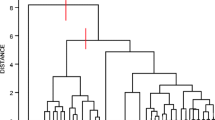Abstract
The identification and categorization of similar objects or individuals into groups is a universal theme that permeates science and provides a conceptual framework to facilitate comprehension. For mental health administrators, a sound methodology to group individuals in a meaningful way would prove useful in the areas of general system understanding, as well as staffing, program planning and evaluation, and service system research, to name a few. Cluster analysis is a set of techniques that approach this grouping process empirically. Within the context of a large psychiatric hospital system, both the methodological processes involved in the application of cluster analysis and the resulting utility of such an analysis are discussed. Issues fundamental to the understanding of such a system are addressed. Special emphasis is placed on methodological issues regarding the application of cluster analytic techniques, which have left such techniques open for criticism. The value of such analyses, when used appropriately, is illustrated by the development of a stable, five-group typology of psychiatric hospital residents whose group characteristics are particularly germane to service system understanding. The implications of such a model for administration, planning, and research in a psychiatric hospital system are also addressed.
Similar content being viewed by others
References
Gnanadesikan R (chair), Panel on Discriminant Analysis, Classification, and Clustering: Discriminant analysis and clustering.Statistical Science 1989; 4:34–69.
Tryon RC, Bailey DE:Cluster Analysis. New York: McGraw-Hill, 1970.
Green PE:Mathematical Tools for Applied Multivariate Analysis. San Diego: Academic Press, Inc., 1978.
Seber GAF:Multivariate Observations. New York: Wiley, 1984.
Taube C, Lee ES, Forthofer RN: DRGs in psychiatry: An empirical evaluation.Medical Care 1984; 22:597–610.
Morrissev JP, Goldman HH, Klerman LV, et al.:The Enduring Asylum. New York: Grune & Stratton, 1980.
Kiesler CA, Sibulkin AE:Mental Hospitalization: Myths and Facts About a National Crisis. Newbury Park, CA: Sage, 1987.
Goldman HH, Taube CA, Regier DA, et al.: The multiple functions of the state mental hospital.American Journal of Psychiatry 1983; 140:296–300.
Gralnick A: Build a better state hospital: Deinstitutionalization has failed.Hospital and Community Psychiatry 1985; 36:738–741.
Rosenstein MJ, Steadman HJ, Milazzo-Sayre LJ, et al.:Statistical Note 177, Characteristics of Adminissions to the Inpatient Services of State and County Mental Hospitals, United States, 1980. DHHS Pub. No. (ADM) 86-1479. Rockville, MD: Department of Health and Human Services, 1986.
Reuter J, Gustafson DH: Need, demand, and utilization models for the mental health system. In: Kessler LG (Ed.):Operations Research and the Mental Health System. Volume I: Report of Ad Hoc Advisory Group National Institute of Mental Health, Series HN No. 1. DHHS Publication No. (ADM) 80-1018. Washington, DC: Superintendent of Documents, U.S. Government Printing Office, 1981.
The New York State Level of Care Survey (Form OMH 103). Albany, NY: New York State Office of Mental Health, 1988.
Seber GAF:Linear Regression Analysis. New York: John Wiley and Sons, 1977.
Neter J, Wasserman W, Kutner MH:Applied linear statistical models. Homewood, IL: Irwin, 1990.
Weisberg S:Applied Linear Regression. New York: John Wiley and Sons, 1985.
Nunnally JC:Psychometric Theory. New York: McGraw-Hill, 1978.
Crocker L, Algina J:Introduction to Classical and Modern Test Theory. Fort Worth, TX: Holt, Rinehart and Winston, Inc., 1986.
Cochran WG:Sampling Techniques. New York: John Wiley and Sons, 1977.
Honigfeld G, Gillis RD, Klett CJ: NOSIE-30: A treatment sensitive behavior scale.Psychological Reports 1966; 19:180–182.
Tukey JW:Exploratory Data Analysis. Reading, MA: Addison-Wesley, 1977.
Velleman PF, Hoaglin DC:Applications, Basics, and Computing of Exploratory Data Analysis. Boston, MA: Duxbury Press, 1981.
Casper ES, Donaldson B: Subgroups in the population of frequent users of inpatient services.Hospital and Community Psychiatry 1990; 41:189–191.
Ward JH, Jr.: Hierarchical grouping to optimize an objective function.American Statistical Association Journal 1963; 58:236–244.
Morey LC, Blashfield RK, Skinner HA: A comparison of cluster analysis techniques within a sequential validation framework.Multivariate Behavioral Research 1983; 18:309–329.
Cattell RB: The meaning and strategic use of factor analysis. In: Cattell RB (Ed.):Handbook of Multivariate Experimental Psychology. Chicago: Rand McNally, 1966.
Holohean EJ, Jr., Banks SM, Maddy BA: Subgroups of psychiatric hospital residents: Implications for service system administration.Hospital and Community Psychiatry 1993; 44:1002–1004.
Schwartz SR, Goldfinger SM: The new chronic patient: Clinical characteristics of an emerging subgroup.Hospital and Community Psychiatry 1981; 32:470–474.
Pepper B, Kirshner MC, Ryglewicz H: The young adult chronic patient: Overview of a population.Hospital and Community Psychiatry 1981; 33:463–469.
Bachrach LL: Young adult chronic patients: An analytical review of the literature.Hospital and Community Psychiatry 1982; 33:189–197.
Lamb HR: Young adult chronic patients: The new drifters.Hospital and Community Psychiatry 1982; 33:465–468.
Tardiff K, Sweillam A: Assaultive behavior among chronic inpatients.American Journal of Psychiatry 1982; 139:212–215.
Holohean EJ, Jr., Pulice RT, Donahue SA: Utilization of acute inpatient psychiatric services: “Hevy users” in New York State.Administration and Policy in Mental Health 1991; 18:173–181.
Kleinrock L:Queueing Systems. Volume I: Theory. New York: Wiley, 1974.
Weinstein AS, Cohen M: Young chronic patients and changes in the state hospital population.Hospital and Community Psychiatry 1984; 35:595–600.
Crow TJ: Molecular pathology of schizophrenia: More than one disease process?,British Medical Journal 1980; 280:66–68.
Andreasen NC, Olsen S: Negative v. positive schizophrenia.Archives of General Psychiatry 1982; 39: 789–794.
Crow TJ: The two-syndrome concept: Origins and current status.Schizophrenia Bulletin 1985; 11:471–485.
Lamb HR: An empirical typology of the chronically mentally ill.Community Mental Health Journal 1986; 22:21.
Holohean EJ, Jr., Carpinello SE, Knight EL: Primary Self-Help Group Purpose: An Empirical Examination. Paper presented at the Mental Health Statistics Improvement Program Center for Mental Health Services, 1993 National Conference on Mental Health Statistics, Washington, DC.
Author information
Authors and Affiliations
Rights and permissions
About this article
Cite this article
Holohean, E.J., Banks, S.M. & Maddy, B.A. System impact and methodological issues in the development of an empirical topology of psychiatric hospital residents. The Journal of Mental Health Administration 22, 177–188 (1995). https://doi.org/10.1007/BF02518757
Issue Date:
DOI: https://doi.org/10.1007/BF02518757




